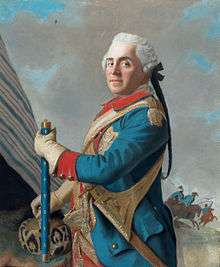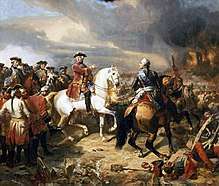Maurice de Saxe
Maurice, Count of Saxony (German: Hermann Moritz von Sachsen, French: Maurice de Saxe; 28 October 1696 – 20 November 1750) was a notable soldier, officer and a famed military commander of the 18th century. The son of Augustus II the Strong, King of Poland and Elector of Saxony, he initially served in the Army of the Holy Roman Empire, then the Imperial Army before finally entering French service. De Saxe became a Marshal and even Marshal General of France. He is best known for his deeds in the War of the Austrian Succession and for his decisive victory at the Battle of Fontenoy especially. He is honoured by the Walhalla Memorial.
| Maurice de Saxe | |||||
|---|---|---|---|---|---|
| Count of Saxony Marshal General of France | |||||
Maurice de Saxe wearing the Polish Order of the White Eagle, 1748 | |||||
| Born | 28 October 1696 Goslar | ||||
| Died | 20 November 1750 (aged 54) Château de Chambord | ||||
| Burial | Saint Thomas Church, Strasbourg | ||||
| Spouse | Johanna Viktoria von Loeben | ||||
| Issue | August Adolf von Sachsen Marie-Aurore de Saxe | ||||
| |||||
| Father | Augustus II of Poland | ||||
| Mother | Maria Aurora of Königsmarck | ||||
Childhood
Maurice was born at Goslar, an illegitimate son of Augustus II the Strong, King of Poland and Elector of Saxony, and the Countess Maria Aurora of Königsmarck. He was the first of eight extramarital children whom August acknowledged, although as many as 354 are claimed by sources, including Wilhelmine of Bayreuth, to have existed.[1]
In 1698, the Countess sent him to his father in Warsaw. August had been elected King of Poland in the previous year, but the unsettled condition of the country obliged Maurice to spend the greater part of his youth outside its borders. This separation from his father made him independent and had an important effect on his future career.[1]
Military career



At the age of twelve, Maurice served in the Imperial Army under Prince Eugene of Savoy, at the sieges of Tournai and Mons and at the Battle of Malplaquet. A proposal at the end of the campaign to send him to a Jesuit college in Brussels was dropped due to the protests of his mother.
Upon his return to the camp of the Allies at the beginning of 1710, Maurice displayed a courage so impetuous that Prince Eugene admonished him to not confuse rashness with valour.[1]
He next served under Peter the Great against the Swedes. In 1711, August formally recognized him and Maurice was granted the rank of Count (Graf). He then accompanied his father to Pomerania, and in 1712 he took part in the Battle of Gadebusch. At the age of 17 in 1713 he commanded his own regiment of the Royal Saxon Army.[1]
In manhood, Maurice bore a strong resemblance to his father, both physically and in character. His grasp was so powerful that he could bend a horseshoe with his hand, and even at the end of his life, his energy and endurance were scarcely affected by the illnesses his many excesses had caused.[1]
On 12 March 1714, a marriage was arranged between him and one of the richest of his father's subjects, Countess Johanna Viktoria Tugendreich von Loeben, but he dissipated her fortune so rapidly that he was soon heavily in debt. The next year (21 January 1715), Johanna gave birth to a son, called August Adolf after his grandfather; the child only lived a few hours. Since Maurice had also given her more serious grounds of complaint against him, he consented to an annulment of the marriage on 21 March 1721.[1]
After serving the German Emperor Charles VI in a campaign against the Ottoman Empire in 1717, he went to Paris to study mathematics, and in 1720 obtained a commission as maréchal de camp. In 1725, he entered negotiations for election as Duke of Courland, at the insistence of the Duchess Anna Ivanovna, who offered him her hand. He was chosen Duke in 1726, but declined marriage with the duchess. He soon found it impossible to resist her opposition to his claims, but with the assistance of £30,000 lent him by the French actress Adrienne Lecouvreur, he raised a force by which he maintained his authority till 1727, when he withdrew and took up residence in Paris.[1] Lecouvreur was to die mysteriously shortly afterwards: there is controversy as to whether or not she was poisoned by her rival, Maria Karolina Sobieska, Duchess of Bouillon.
At the outbreak of the War of the Polish Succession, Saxe served under Marshal the Duke of Berwick, and for a brilliant exploit at the Siege of Philippsburg he was named lieutenant-general. In the War of the Austrian Succession he took command of an army division sent to invade Austria in 1741, and on 19 November 1741, surprised Prague during the night, and seized it before the garrison was aware of the presence of an enemy, a coup de main which made him famous throughout Europe; he thus repeated the exploit of 1648 of his maternal great-grandfather, Hans Christoff von Königsmarck. After capturing the fortress of Eger (Cheb) on 19 April 1742, he received a leave of absence, and went to Russia to push his claims for the Duchy of Courland, but returned to his command after getting nowhere.[1]
Saxe's exploits were the sole redeeming feature in an unsuccessful campaign, and on 26 March 1743, his merits were rewarded by promotion to Marshal of France. He had been given only 50-60,000 men to defend against an enemy army twice as large.[2] From this time on, he became one of the great generals of the age. In 1744, he was chosen to command the 10,000 men of the French invasion of Britain on behalf of James Francis Edward Stuart, which assembled at Dunkirk but did not proceed more than a few miles out of harbour before being wrecked by disastrous storms.[3] After its termination, he received an independent command in the Netherlands, and by skilful manoeuvering succeeded in continually harassing the superior forces of the enemy without risking a decisive battle.[1]

In the following year, Saxe with 65,000 men besieged Tournai and inflicted a severe defeat on the army of the Duke of Cumberland at the Battle of Fontenoy, an encounter determined entirely by his constancy and cool leadership.[4] During the battle, he was unable to sit on horseback due to edema, and was carried about in a wicker chariot.[1]
In recognition of his brilliant achievement, Louis XV conferred on him the Château de Chambord for life, and in April 1746, he was naturalised as a French subject. Until the end of the war, he continued to command in the Netherlands, always with success.[5] Besides Fontenoy he added Rocoux (1746) and Lawfeldt or Val (1747) to the list of French victories. He led the French force which captured Brussels and it was under his orders that Marshal Löwendahl captured Bergen op Zoom. He himself won the last success of the war in capturing Maastricht in 1748. In 1747 the title once held by Turenne and Villars, "Marshal General of the King's camps and armies", was revived for him. But on 20 November 1750 he died at the Château de Chambord "of a putrid fever".[1]
During the last years of his life, Maurice had an affair with a French lady, Marie Rinteau, who at that time was only eighteen years old. In 1748 she gave birth to a daughter, the last of Maurice's several illegitimate children. She was called Maria Aurora (in French: Marie Aurore) after her grandmother. She bore the surname de la Rivière until 1766 when the Parlement of Paris formally recognized her parentage and she could assume the surname of von Sachsen or de Saxe. Marie Aurore married firstly in 1766 with Antoine, comte d'Horne (1722–1767), an alleged illegitimate son of Louis XV of France. By her second marriage with Louis Claude Dupin de Francueil (in 1777), she was the grandmother of Amandine Lucile Aurore Dupin, who later became famous as the writer George Sand. Maria Aurore died on 25 December 1821 when her granddaughter George Sand was seventeen. Sand included details of her grandmother's parentage in her memoires [1]
Writings

Saxe's work on the art of war, Mes Rêveries was published after his death in 1757.[6] Described by Carlyle as "a strange military farrago, dictated, as I should think, under opium", it was praised by Frederick the Great and described by Lord Montgomery, more than two centuries later, as "a remarkable work on the art of war."
A common theme of the 18th century Age of Enlightenment was to emphasise scientific method and the idea every activity could be expressed in terms of a universal system.[7] In one sense, Mes Rêveries followed this by subjecting "military affairs to reasoned criticism and intellectual treatment, and the ensuing military doctrines were perceived as forming a definitive system."[8] Written following Prussian expansion during the War of the Austrian Succession, Saxe rejected their rigid discipline; arguing the French character was fundamentally different and their tactics should reflect that, he advocated the use of a deep order or ordre profond, rather than relying on firearms.[9]
However, Mes Rêveries also challenged French military orthodoxy in arguing for a greater focus on mobile warfare, rather than fortifications; this was partly a legacy of Vauban (1633-1707), who had revolutionised this field but adherence to his principles meant French engineers became ultra-conservative. As early as 1701, John Churchill, 1st Duke of Marlborough argued winning one battle was more beneficial than taking 12 fortresses; Saxe followed this line but his argument was given increased weight by French losses in the 1756-1763 Seven Years' War.[10]
Saxe's Lettres et mémoires choisis appeared in 1794. His letters to his sister Anna Karolina Orzelska, the Duchess of Schleswig-Holstein-Sonderburg-Beck, preserved at Strasbourg, were destroyed by the bombardment of that place in 1870.[1] Thirty copies had, however, been printed from the original.[1]
Many previous errors in former biographies were corrected and additional information supplied in Karl von Weber's Moritz Graf von Sachsen, Marschall von Frankreich, nach archivalischen Quellen [Moritz Count of Saxony, Marshal of France, after archival sources] (Leipzig: Tauchnitz, 1863), in Saint-René Taillandier's Maurice de Saxe, étude historique d'après les documents des archives de Dresde [Maurice of Saxe, historical study according to the documents in the archives of Dresden] (1865) and in Comte Carl Friedrich Vitzthum von Eckstädt's Maurice de Saxe (Leipzig, 1861).[1]
A biography in English is Jon Manchip White's Marshal of France: The Life and Times of Maurice, Comte de Saxe [1696–1750] (Rand McNally & Company, Chicago, 1962). See also the military histories of the period, especially Carlyle's Frederick the Great.[1]
Ancestry
| Ancestors of Maurice de Saxe | ||||||||||||||||||||||||||||||||||||||||||||||||||||||||||||||||||||||||||||||||||||||||||||||||||||||||||||||||||||||||||||||||||||||||||||||||||||||||||||||||||||||||||||||||||||||||||||||||||||||||||||||||||||||||||||||||||||||||||||||||||||||||||||||||||||||||||||||||||||||||||||||||||||||||||||||||||||||||||||||||||||||||||||||||||||||||||||||||||||||||||||||||||||||||||||||||||||||||||||||||||||||||||||||||||||||||||||||||||||||||||||||||||||||||||||||||||||||||||||||||||||||||||||||||||||||||||||||||||||||||||||||||||||||||||||||||||||||||||||||||||||||||||||||||||||||||||||||||
|---|---|---|---|---|---|---|---|---|---|---|---|---|---|---|---|---|---|---|---|---|---|---|---|---|---|---|---|---|---|---|---|---|---|---|---|---|---|---|---|---|---|---|---|---|---|---|---|---|---|---|---|---|---|---|---|---|---|---|---|---|---|---|---|---|---|---|---|---|---|---|---|---|---|---|---|---|---|---|---|---|---|---|---|---|---|---|---|---|---|---|---|---|---|---|---|---|---|---|---|---|---|---|---|---|---|---|---|---|---|---|---|---|---|---|---|---|---|---|---|---|---|---|---|---|---|---|---|---|---|---|---|---|---|---|---|---|---|---|---|---|---|---|---|---|---|---|---|---|---|---|---|---|---|---|---|---|---|---|---|---|---|---|---|---|---|---|---|---|---|---|---|---|---|---|---|---|---|---|---|---|---|---|---|---|---|---|---|---|---|---|---|---|---|---|---|---|---|---|---|---|---|---|---|---|---|---|---|---|---|---|---|---|---|---|---|---|---|---|---|---|---|---|---|---|---|---|---|---|---|---|---|---|---|---|---|---|---|---|---|---|---|---|---|---|---|---|---|---|---|---|---|---|---|---|---|---|---|---|---|---|---|---|---|---|---|---|---|---|---|---|---|---|---|---|---|---|---|---|---|---|---|---|---|---|---|---|---|---|---|---|---|---|---|---|---|---|---|---|---|---|---|---|---|---|---|---|---|---|---|---|---|---|---|---|---|---|---|---|---|---|---|---|---|---|---|---|---|---|---|---|---|---|---|---|---|---|---|---|---|---|---|---|---|---|---|---|---|---|---|---|---|---|---|---|---|---|---|---|---|---|---|---|---|---|---|---|---|---|---|---|---|---|---|---|---|---|---|---|---|---|---|---|---|---|---|---|---|---|---|---|---|---|---|---|---|---|---|---|---|---|---|---|---|---|---|---|---|---|---|---|---|---|---|---|---|---|---|---|---|---|---|---|---|---|---|---|---|---|---|---|---|---|---|---|---|---|---|---|---|---|---|---|---|---|---|---|---|---|---|---|---|---|---|---|---|---|---|---|---|---|---|---|---|---|---|---|---|---|---|---|---|---|---|---|---|---|---|---|---|---|---|---|---|---|---|---|---|---|---|---|---|---|---|---|---|---|---|---|---|---|---|---|---|---|---|---|---|---|---|---|---|---|---|---|---|---|---|---|---|---|---|---|---|---|---|---|---|---|---|---|---|---|---|---|---|---|---|---|---|---|---|---|---|---|---|---|---|---|---|---|---|---|---|---|---|---|---|---|---|---|---|---|---|---|---|---|---|---|---|---|---|---|---|---|---|---|---|---|---|---|---|---|---|---|---|---|---|---|---|---|---|---|
| ||||||||||||||||||||||||||||||||||||||||||||||||||||||||||||||||||||||||||||||||||||||||||||||||||||||||||||||||||||||||||||||||||||||||||||||||||||||||||||||||||||||||||||||||||||||||||||||||||||||||||||||||||||||||||||||||||||||||||||||||||||||||||||||||||||||||||||||||||||||||||||||||||||||||||||||||||||||||||||||||||||||||||||||||||||||||||||||||||||||||||||||||||||||||||||||||||||||||||||||||||||||||||||||||||||||||||||||||||||||||||||||||||||||||||||||||||||||||||||||||||||||||||||||||||||||||||||||||||||||||||||||||||||||||||||||||||||||||||||||||||||||||||||||||||||||||||||||||
References
- 1911 Encyclopædia Britannica.
- White, p. 138
- White, p. 132
- White, p. 147
- White, p. 181
- de Saxe, Field Marshal Herman Maurice (1757). "Reveries on the Art of War". web.archive.org. London. Archived from the original on February 5, 2008. Retrieved May 11, 2012.
- Gay, Peter (1996). The Enlightenment: An Interpretation. W.W. Norton & Company. ISBN 978-0393008708.
- Manabrata Guha (2011). Reimagining War in the 21st Century: From Clausewitz to Network-Centric Warfare. Taylor & Francis. p. 24. ISBN 978-0-415-56166-2. Retrieved 6 December 2012.
- Smith, Bryan L. (Spring 2012), From Myth-Conceived to Myth-Understood: France's Revolutionary Ordre Profond Revisited
- Delon. Michel (ed), Picon, Antoine (author) (2001). Encyclopedia of the Enlightenment. Routledge. p. 540. ISBN 978-1579582463.CS1 maint: extra text: authors list (link)

- White, Jon Manchip (1962). Marshal of France: the life and times of Maurice, comte de Saxe, 1696–1750. Rand McNally. ISBN 978-1-258-13994-0.
External links

- Child of Chequer'd Fortune: The Life, Loves and Battles of Maurice de Saxe, Maréchal de France by Marjorie Bowen at Project Gutenberg Australia